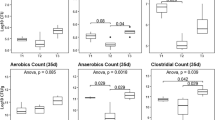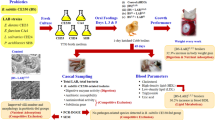Abstract
Sixty-week-old Hy-Line brown laying hens were randomly divided into five groups and fed different diets over a period of 84 days. Experimental treatments included a basal diet (control); the basal diet supplemented with 1.0 × 106B. licheniformis yb-214245; the basal diet supplemented with 1.0 × 106B. subtilis yb-114246; a combination of both strains in a 2:1 ratio (6.6 × 105:3.3 × 105B. licheniformis yb-214245:B. subtilis yb-114246); and the latter, added with 5 mg/kg flavomycin. Basal diet supplementation with the combined Bacillus species improved egg-laying performance in aging hens significantly (P < 0.05). Eggshell strength improved significantly with this treatment, compared to the control or the antibiotic-supplemented groups (P < 0.05). The levels of total cholesterol, triglycerides, and very low-density lipoprotein cholesterol in egg yolk declined significantly more in the Bacillus-treated group than in the control or the antibiotic-supplemented groups (P < 0.01). Small intestinal morphology was better in the hens treated with the Bacillus combination than in the hens in the control group (P < 0.05). The total number of aerobic bacteria (Bacillus, Lactobacillus, and Bifidobacterium) in the cecum was significantly higher in all the Bacillus-supplemented hens than either in the control or the antibiotic-supplemented hens (P < 0.01); additionally, the number of E. coli and Salmonella was significantly lower than in the control group (P < 0.01). In conclusion, diet supplementation with the combination of Bacillus species used here for aging laying hens improved their growth performance, cecal bacterial composition, egg quality, and small intestine morphology.
Similar content being viewed by others
References
Wang X, Ryu D, Houtkooper RH, Auwerx J (2015) Antibiotic use and abuse: a threat to mitochondria and chloroplasts with impact on research, health, and environment. Bioessays 37:1045–1053. https://doi.org/10.1002/bies.201500071
Hill C, Guarner F, Reid G, Gibson GR, Merenstein DJ, Pot B, Morelli L, Canani RB, Flint HJ, Salminen S, Calder PC, Sanders ME (2014) Expert consensus document. The International Scientific Association for Probiotics and Prebiotics consensus statement on the scope and appropriate use of the term probiotic. Nat Rev Gastroenterol Hepatol 1:506–514. https://doi.org/10.1038/nrgastro.2014.66.
Hooper LV, Gordon JI (2001) Commensal host-bacterial relationships in the gut. Science 292:1115–1158. https://doi.org/10.1126/science.1058709
Setlow P (1994) Mechanisms which contribute to the long-term survival of spores of Bacillus species. J Bacteriol 76:49–60. https://doi.org/10.1111/j.1365-2672.1994.tb04357.x.
Nicholson WL (2002) Roles of Bacillus endospores in the environment. Cell Mol Life Sci 59:410–416. https://doi.org/10.1007/s00018-002-8433-7
Fuller R (1989) Probiotics in man and animals. J Appl Bacteriol 66:365–378. https://doi.org/10.1111/j.1365-2672.1989.tb05105.x
Kristensen NB, Bryrup T, Allin KH, Nielsen T, Hansen TH, Pedersen O (2016) Alterations in fecal microbiota composition by probiotic supplementation in healthy adults: a systematic review of randomized controlled trials. Genome Med 8:52. https://doi.org/10.1186/s13073-016-0300-5
Bubnov RV, Babenko LP, Lazarenko LM, Mokrozub VV, Spivak MY (2018) Specific properties of probiotic strains: relevance and benefits for the host. EPMA J 9:205–223. https://doi.org/10.1007/s13167-018-0132-z
Alexopoulos C, Georgoulakis IE, Tzivara A, Kyriakis CS, Govaris A, Kyriakis SC (2004) Field evaluation of the effect of a probiotic-containing Bacillus licheniformis and Bacillus subtilis spores on the health status, performance, and carcass quality of grower and finisher pigs. J Vet Med A Physiol Pathol Clin Med 51:306–312. https://doi.org/10.1111/j.1439-0442.2004.00637.x
Liu CH, Chiu CH, Wang SW, Cheng W (2012) Dietary administration of the probiotic Bacillus subtilis E20 enhances the growth, innate immune responses, and disease resistance of the grouper, Epinephelus coioides. Fish Shellfish Immunol 33:699–706. https://doi.org/10.1016/j.fsi.2012.06.012
Jeong JS, Kim IH (2014) Effect of Bacillus subtilis C-3102 spores as a probiotic feed supplement on growth performance, noxious gas emission, and intestinal microflora in broilers. Poultry Sci 93:3097–3103. https://doi.org/10.3382/ps.2014-04086
Bader J, Albin A, Stahl U (2012) Spore-forming bacteria and their utilization as probiotics. Benefic Microbes 3:67–75. https://doi.org/10.3920/BM2011.0039
Adorian TJ, Jamali H, Farsani HG, Darvishi P, Hasanpour S, Bagheri T, Roozbehfar R (2018) Effects of probiotic bacteria Bacillus on growth performance, digestive enzyme activity, and hematological parameters of Asian sea bass, Lates calcarifer (Bloch). Probiotics Antimicrob Proteins. https://doi.org/10.1007/s12602-018-9393-z
Moeller R, Setlow P, Reitz G, Nicholson WL (2009) Roles of small, acid-soluble spore proteins and core water content in survival of Bacillus subtilis spores exposed to environmental solar UV radiation. Appl Environ Microbiol 75:5202–5208. https://doi.org/10.1128/AEM.00789-09
Bai K, Feng C, Jiang L, Zhang L, Zhang J, Zhang L, Wang T (2018) Dietary effects of Bacillus subtilis fmbj on growth performance, small intestinal morphology, and its antioxidant capacity of broilers. Poultry Sci 97:2312–2321. https://doi.org/10.3382/ps/pey116
Vilà B, Fontgibell A, Badiola I, Esteve-Garcia E, Jiménez G, Castillo M, Brufau J (2009) Reduction of Salmonella enterica var. Enteritidis colonization and invasion by Bacillus cereus var. toyoi inclusion in poultry feeds. Poultry Sci 88:975–979. https://doi.org/10.3382/ps.2008-00483
Hatab MH, Elsayed MA, Ibrahim NS (2016) Effect of some biological supplementation on productive performance, physiological and immunological response of layer chicks. J Radiat Res Appl Sci 9:185–192. https://doi.org/10.1016/j.jrras.2015.12.008
Lei K, Li YL, Yu DY, Rajput IR, Li WF (2013) Influence of dietary inclusion of Bacillus licheniformis on laying performance, egg quality, antioxidant enzyme activities, and intestinal barrier function of laying hens. Poultry Sci 92:2389–2395. https://doi.org/10.3382/ps.2012-02686
Mountzouris KC, Tsitrsikos P, Palamidi I, Arvaniti A, Mohnl M, Schatzmayr G, Fegeros K (2010) Effects of probiotic inclusion levels in broiler nutrition on growth performance, nutrient digestibility, plasma immunoglobulins, and cecal microflora composition. Poultry Sci 89:58–67. https://doi.org/10.3382/ps.2009-00308
Sharifi SD, Dibamehrb A, Lotfollahian H, Baurhoo B (2012) Effects of flavomycin and probiotic supplementation to diets containing different sources of fat on growth performance, intestinal morphology, apparent metabolizable energy, and fat digestibility in broiler chickens. Poultry Sci 91:918–927. https://doi.org/10.3382/ps.2011-01844
Ma QG, Gao X, Zhou T, Zhao LH, Fan Y, Li XY, Lei YP, Ji C, Zhang JY (2012) Protective effect of Bacillus subtilis ANSB060 on egg quality, biochemical and histopathological changes in layers exposed to aflatoxin B1. Poultry Sci 91:2852–2857. https://doi.org/10.3382/ps.2012-02474
Abdelqader A, Al-Fataftah AR, Das G (2013) Effects of dietary Bacillus subtilis and inulin supplementation on performance, eggshell quality, intestinal morphology and microflora composition of laying hens in the late phase of production. Anim Feed Sci Technol 179:103–111. https://doi.org/10.1016/j.anifeedsci.2012.11.003
Yang JJ, Qian K, Wu D, Zhang W, Wu YJ, Xu YY (2017) Effects of different proportions of two bacillus strains on the growth performance, small intestinal morphology, caecal microbiota and plasma biochemical profile of Chinese Huainan Partridge Shank chickens. J Integr Agric 16:1383–1392. https://doi.org/10.1016/S2095-3119(16)61510-1
Chapman CM, Gibson GR, Rowland I (2011) Health benefits of probiotics: are mixtures more effective than single strains? Eur J Nutr 50:1–17. https://doi.org/10.1007/s00394-010-0166-z
Zhang JL, Xie QM, Ji J, Yang WH, Wu YB, Li C, Ma JY, Bi YZ (2012) Different combinations of probiotics improve the production performance, egg quality, and immune response of layer hens. Poultry Sci 91:2755–2760. https://doi.org/10.3382/ps.2012-02339
Forte C, Moscati L, Acuti G, Mugnai C, Franciosini MP, Costarelli S, Cobellis G, Trabalza-Marinucci M (2016) Effects of dietary Lactobacillus acidophilus and Bacillus subtilis on laying performance, egg quality, blood biochemistry and immune response of organic laying hens. J Anim Physiol Anim Nutr (Berl) 100:977–987. https://doi.org/10.1111/jpn.12408
The National Academies of Sciences, Engineering, and Medicine; Health and Medicine Division; Food and Nutrition Board; Food Forum. (2017) Nutrition Across the Lifespan for Healthy Aging: Proceedings of a Workshop. Washington (DC): National Academies Press (US). https://www.ncbi.nlm.nih.gov/books/NBK430985/. Accessed 15 May 2018
National Research Council (US) Committee for the Update of the Guide for the Care and Use of Laboratory Animals (2011) Guide for the care and use of laboratory animals, Eighth edn. The National Academies Press, Washington DC https://www.nap.edu/catalog/12910/guide-for-the-care-and-use-of-laboratory-animals-eighth. Accessed 15 May 2018
NRC (National Research Council) (1994) Nutrient requirement of poultry, 9th edn. National Academy Press, USA http://www.nap.edu/catalog/2114.html. Accessed 7 March 2017
Mountzouris KC, Tsirtsikos P, Kalamara E, Nitsch S, Schatzmayr G, Fegeros K (2007) Evaluation of the efficacy of a probiotic containing Lactobacillus, Bifidobacterium, Enterococcus, and Pediococcus strains in promoting broiler performance and modulating cecal microflora composition and metabolic activities. Poultry Sci 86:309–317. https://doi.org/10.1093/ps/86.2.309
Karcher DM, Jones DR, Abdo Z, Zhao Y, Shepherd TA, Xin H (2015) Impact of commercial housing systems and nutrient and energy intake on laying hen performance and egg quality parameters. Poultry Sci 94:485–501. https://doi.org/10.3382/ps/peu078
Chatzispyrou IA, Held NM, Mouchiroud L, Auwerx J, Houtkooper RH (2015) Tetracycline antibiotics impair mitochondrial function and its experimental use confounds research. Cancer Res 75:4446–4469. https://doi.org/10.1158/0008-5472.CAN-15-1626
Guo JR, Dong XF, Liu S, Tong JM (2017) Effects of long-term Bacillus subtilis CGMCC 1.921 supplementation on performance, egg quality, and fecal and cecal microbiota of laying hens. Poultry Sci 96:1280–1289. https://doi.org/10.3382/ps/pew389
Al-Shahrani S, Naidoo V (2015) Florfenicol induces early embryonic death in eggs collected from treated hens. BMC Vet Res 11:213. https://doi.org/10.1186/s12917-015-0536-0
Louis P, Scott KP, Duncan SH, Flint HJ (2007) Understanding the effects of diet on bacterial metabolism in the large intestine. J Appl Microbiol 102:1197–1208. https://doi.org/10.1111/j.1365-2672.2007.03322.x
Yang JJ, Qian K, Wang CL, Wu YJ (2018) Roles of probiotic Lactobacilli inclusion in helping piglets establish healthy intestinal inter-environment for pathogen defense. Probiotics Antimicrob Proteins 2:243–250. https://doi.org/10.1007/s12602-017-9273-y
Ooi LG, Liong MT (2010) Cholesterol-lowering effects of probiotics and prebiotics: a review of in vivo and in vitro findings. Int J Mol Sci 11:2499–2522. https://doi.org/10.3390/ijms11062499
Xiao JZ, Kondo S, Takahashi N, Miyaji K, Oshida K, Hiramatsu A, Iwatsuki K, Kokubo S, Hosono A (2003) Effects of milk products fermented by Bifdobacterium longum on blood lipids in rats and healthy adult male volunteers. J Dairy Sci 86:2452–2461. https://doi.org/10.3168/jds.S0022-0302(03)73839-9
Giannenas I, Tsalie E, Triantafillou E, Hessenberger S, Teichmann K, Mohnl M, Tontis D (2014) Assessment of probiotics supplementation via feed or water on the growth performance, intestinal morphology and microflora of chickens after experimental infection with Eimeria acervulina, Eimeria maxima and Eimeria tenella. Avian Pathol 43:209–216. https://doi.org/10.1080/03079457.2014.899430
Jiang YB, Yin QQ, Yang YR (2009) Effect of soybean peptides on growth performance, intestinal structure and mucosal immunity of broilers. J Anim Physiol Anim Nutr (Berl) 93:754–760. https://doi.org/10.1111/j.1439-0396.2008.00864.x
Xu ZR, Hu CH, Xia MS, Zhan XA, Wang MQ (2003) Effects of dietary fructooligosaccharide on digestive enzyme activities, intestinal microflora and morphology of male broilers. Poult Sci 82:1030–1036. https://doi.org/10.1093/ps/82.6.1030
Mappley LJ, Tchorzewska MA, Cooley WA, Woodward MJ, La Ragione RM (2011) Lactobacilli antagonize the growth, motility, and adherence of Brachyspira pilosicoli: a potential intervention against avian intestinal spirochetosis. Appl Environ Microbiol 77:5402–5411. https://doi.org/10.1128/AEM.00185-11
Sugiharto S, Isroli I, Yudiarti T, Widiastuti E (2018) The effect of supplementation of multistrain probiotic preparation in combination with vitamins and minerals to the basal diet on the growth performance, carcass traits, and physiological response of broilers. Vet World 11:240–247. https://doi.org/10.14202/vetworld.
Ouwehand AC, Invernici MM, Furlaneto FAC, Messora MR (2018) Effectiveness of multistrain versus single-strain probiotics: current status and recommendations for the future. J Clin Gastroenterol 52:S35–S40. https://doi.org/10.1097/MCG.0000000000001052
Funding
The work was supported by the fund of the Natural Science Foundation of Anhui province (No. 1708085QC72), the National System for Layer Production Technology of China (No. CARS-40-K21), and the State Key Laboratory of Animal Nutrition (No.2004D125184f1703). The funders had no role in the design of the study and collection, analysis, and interpretation of data and in writing of the manuscript.
Author information
Authors and Affiliations
Contributions
The contribution of the authors was as follows: JY and KZ designed the study; JY isolated and cultured B. licheniformis yb-214245 and B. subtilis yb-114246, fed the hens and recorded the growth data, and wrote the paper; WL measured the egg quality; and MZ was involved in technical direction.
Corresponding authors
Ethics declarations
Ethics Approval and Consent to Participate
The experimental protocols in this study including animal husbandry and slaughter were approved by the Institution of Animal Science and Welfare of Anhui Province (No. IASWAP2017030319).
Consent for Publication
Not applicable.
Conflict of Interest
The authors declare that they have no competing interests.
Additional information
Publisher’s Note
Springer Nature remains neutral with regard to jurisdictional claims in published maps and institutional affiliations.
Rights and permissions
About this article
Cite this article
Yang, J., Zhan, K. & Zhang, M. Effects of the Use of a Combination of Two Bacillus Species on Performance, Egg Quality, Small Intestinal Mucosal Morphology, and Cecal Microbiota Profile in Aging Laying Hens. Probiotics & Antimicro. Prot. 12, 204–213 (2020). https://doi.org/10.1007/s12602-019-09532-x
Published:
Issue Date:
DOI: https://doi.org/10.1007/s12602-019-09532-x




